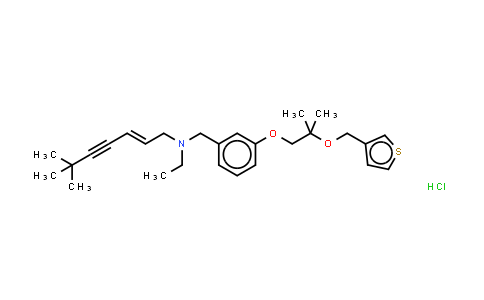
FR194738 NLT 98%
SKU : MC538308
CAS Number : 204067-52-7
Molecular Formula : C27H38ClNO2S | Molecular Weight : 476.11
Quote Request| Purity | NLT 98% |
|---|---|
| Storage | at 20ºC 2 years |
* The above information is for reference only.
* If the product has intellectual property rights, a license granted is must or contact us.
| Chemical Name | FR194738 |
|---|---|
| CAS Number | 204067-52-7 |
| MDL Number | MFCD22572763 |
| Molecular Formula | C27H38ClNO2S |
| Molecular Weight | 476.11 |
FR194738 is a squalene epoxidase inhibitor. FR194738 inhibits squalene epoxidase activity in HepG2 cell homogenates with an IC50 of 9.8 nM. IC50 & Target: IC50: 9.8 nM (squalene epoxidase, in HepG2 cell homogenates)[1] In Vitro: In intact HepG2 cells<, FR194738 concentration-dependently inhibits the incorporation of [14C]acetate into free cholesterol and cholesteryl ester, with IC50s of 4.9 and 8.0 nM, respectively. FR194738 induces intracellular [14C]squalene accumulation. FR194738 increases the incorporation of [14C]acetate into squalene, an intermediate of cholesterol synthesis[1]. FR194738 potently inhibits squalene epoxidase (SE) in HepG2 cell homogenate and liver microsomes in dogs and rats. The inhibitory effect of FR194738 in comparison to the HMG-CoA reductase inhibitors, Simvastatin, Fluvastatin and Pravastatin, on cholesterol biosynthesis in HepG2 cells is examined. Among these compounds, FR194738 is the most potent, with an IC50 of 2.1 nM. The IC50s of Simvastatin, Fluvastatin and Pravastatin are 40, 28 and 5100 nM, respectively[2]. FR194738 inhibits hamster liver microsomal squalene epoxidase activity in a concentration-dependent manner with an IC50 of 14 nM[3]. In Vivo: Serum lipid levels in hamsters after daily administration of FR194738 and Pravastatin for 10 d are measured. FR194738 reduces the serum levels of total, non high density lipoprotein (HDL) and HDL cholesterol, and triglyceride. Treatment of hamsters with FR194738 increases HMG-CoA reductase activity by 1.3-fold at 32 mg/kg compared to the control group and does not significantly change that at 100 mg/kg[3].
Related Products
© Copyright 2015-2024 Hangzhou MolCore BioPharmatech Co.,Ltd. All rights reserved.
